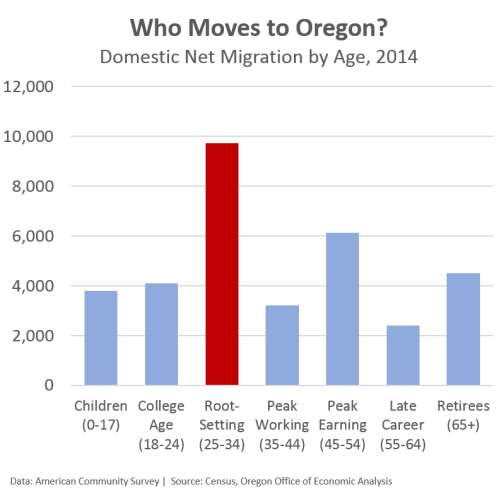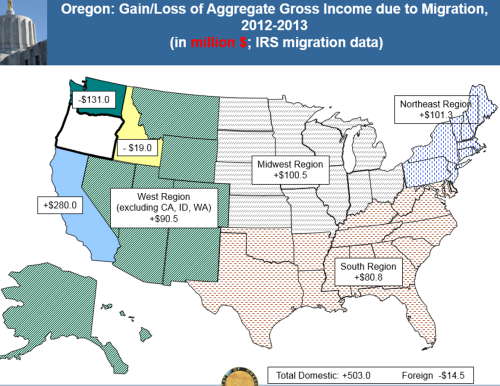![]()
By Josh Lehner
Oregon Office of Economic Analysis Blog
This edition of the Graph of the Week continues our focus on migration into Oregon. Migration is very important to the state and one of the two main reasons Oregon outperforms the typical state during expansions. This also sets the stage for our office’s upcoming research report on young, college educated migrants, to be released in a couple weeks.
In recent years, migration indicators like driver licenses surrendered, school enrollment, and moving van lines data, all pointed toward acceleration in population growth in the state. As the actual data has been released (Portland State and then Census/ACS) it confirms these trends. Net migration into Oregon in is now effectively as large as during the housing boom years, at around 40,000 net new migrants per year. But you already knew that if you follow our office’s work, or PSU’s or various media outlets across the state that have been trumpeting the latest van lines data.
What you might not know is who exactly is moving to Oregon. As you may have suspected, its pretty much everyone. Oregon sees a net influx of residents across all age groups. However, a disproportionate number are in their root-setting years; that important decade from mid-20s to mid-30s when most people settle down, begin their careers in earnest, get married, buy a house and have kids.
These young, working age individuals and households are vital for longer run economic growth. The reason is once a regional economy has such individuals, they rarely leave for another area as migration rates fall considerably from one’s 20s to their 30s and so forth. This means a place like Oregon now has a larger working age population, which can raise the productive capacity and growth rates of the local economy. (Of course, as discussed in our Rural Oregon report, the type of migrants do differ between rural and urban areas.)
Addendum 1:
The two big reasons people move are for jobs and housing. However our office has done some additional work that looks at other characteristics of migrants. Among the factors that lead to higher migration rates are: being single, being young, not being employed, earning lower amounts of income, and having higher educational attainment. Now, that may seem a little bit odd – that collection of characteristics. And it may give some credence to Portlandia’s stereotype, but it really does make sense. Migration is for the young. And migration rates are higher among those with more schooling. So 20- and 30-somethings are more likely to single, more likely to earn less money (they are still early in their careers) and more likely to be unemployed or not in the labor force (one’s peak working years are their late 30s through early 50s).
Addendum 2:
Kanhaiya takes these migration rates by age and by sex, along with some other economic factors — particularly relative unemployment rates, housing prices and the like — and runs them through his population models to create our office’s population and demographic forecasts. As the population’s natural increase (the number of births minus the number of deaths) is slowing considerably, and even turning negative in some locations, the state’s population is being driven more and more by migration.
Addendum 3:
Besides just the overall number of migrants, it is important to look at the relative incomes as well. Particularly for an office that, you know, forecasts state tax revenues. Below is a map Kanhaiya creates based on IRS migration and tax filer data. Oregon loses migrants and income to Washington each and every year. However the inflows from California are always larger and more than compensate for the losses. See slide 12 from Mark’s Destination Oregon presentation at the Oregon Economic Forum for more history on the California and Washington flows. Beyond the northern flow of migrants on the West Coast, Oregon does see net gains from the rest of the country and its regions. Depending upon the year, there are some net outflows to specific states but not a general pattern of losses over time.
Given that young migrants account for the bulk of the total gains into Oregon, our office has a forthcoming report on the young, college educated migrants. Stay tuned for more in a couple of weeks.
Disclaimer: Articles featured on Oregon Report are the creation, responsibility and opinion of the authoring individual or organization which is featured at the top of every article.




